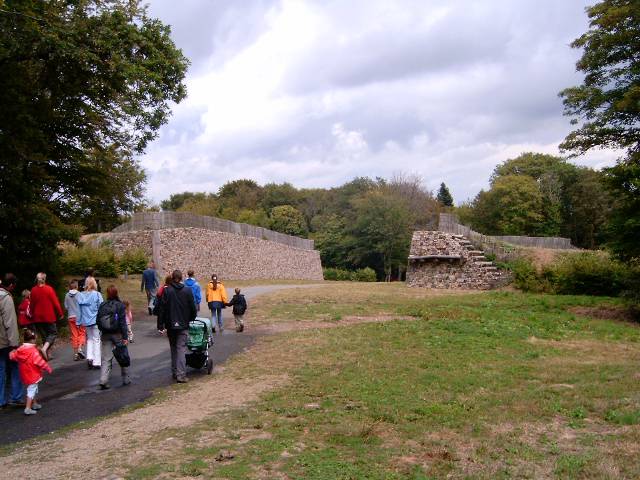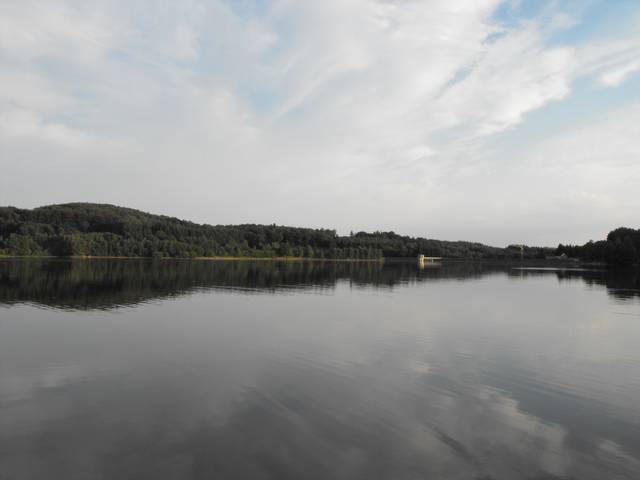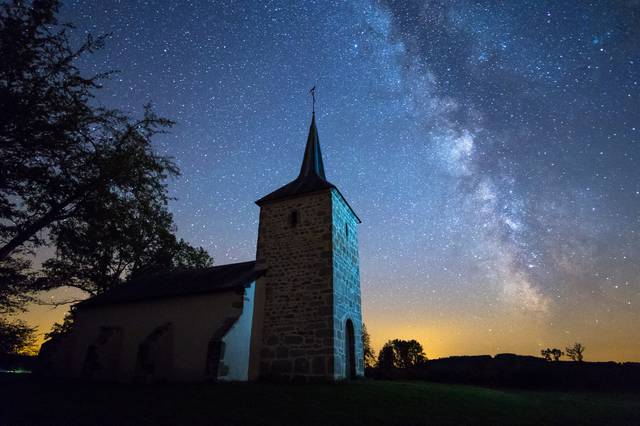
Morvan Regional Natural Park is located in the heart of the Burgundy region of France.

The name Morvan comes from the Celtic: Mar = black and Vand = mountains. The park was established in 1970 and comprises 117 member municipalities. The park covers areas in all four departments of Burgundy: Nièvre, Saône-et-Loire, Yonne and Cote d'Or. In the west and north it borders on the valleys of Bazois Auxois and in the south and east to the plains of Charolais and Autun. Since the last reclassification in 2008, the park covers an area of 290 900 ha, or 9% of the total area of Burgundy. It has 51,357 inhabitants . The Morvan has a rich ecosystem: a combination of forests, farmland, hedgerows and rivers. However, the biosphere is threatened by pollution, uprooting hedges (which are a haven for many species of animals) and damage to hardwood forests.
The establishment of the Morvan Regional Natural Park with 64 participating municipalities was ratified on October 16, 1970. In 1975 Le Maison du Parc was established in Saint Brisson in a complex of buildings, including a castle and its outbuildings, built in 1802 and 1803 by an English architect. From here the park is managed. In addition to the administrative services the complex is home for the park's tourist office, a museum of the resistance in the Morvan during the second world war as well as a network of five houses forming the museum of the Morvan: la Maison des Hommes et des paysages. In 1997 the number of participating municipalities expanded to 94 and in 2008 to 117. The main objective for the park is conservation, control and development of the natural landscape in which tourism is promoted with respect to the local equilibrium.

The Morvan is a mountainous area that is actually an offshoot of the Massif Central. It consists mainly out of granite rock. The highest peak is the Haut-Folin with a height of 901 meters, followed by Mont Preneley of 855 meters. The Mont Beuvray, with its 821 meters and the excavated ancient Celtic town of Bibracte, is among the high peaks. From north to south the Morvan has four areas: Lower Morvan Hill Morvan (Haut-Morvan Colliné), High Morvan (Haut-Morvan Montagnard) and the slightly undulating country of Luzy. Especially the Haut-Morvan Montagnard is covered with large quantities of dense mixed forest interspersed with large meadow areas. There are many water works in the Morvan, including reservoirs such as Lac de Saint-Agnan and Lac des Settons. There are some rivers such as the Yonne, the Arroux, the Cousin and the Auxois. Because industry is lacking, there is little air pollution, so you see at the Milky Way during a cloudless night.
The Morvan has a rich flora and fauna. In spring bloom primroses, orchids, figwort, wood anemones, wood sorrel, wild hyacinth, wild daffodil, parnassus, marsh lousewort, cow-wheat, stachys, etc. The spindle, honeysuckle, raspberry, blackberry and plenty of wild strawberry are widespread! Autumn is the ideal season for many species of mushrooms and fungi. Birds find a paradise: buzzards, hawks, falcons, harriers, kites, even the serpent eagle and osprey circling high in the sky in search of their prey... Many owl species can be found here. Rare birds such as hops, red partridge, kingfisher, dipper, crossbill, flycatcher, hawfinch and ortolan can be observed. To make birdwatchers more enthusiastic: buntings, all kinds of swallows, woodpeckers, chickadees, nuthatch, wren, common redstart, finches, goldfinches and of course culture birds as thrushes, sparrows, magpies, crows and jays are frequent. Big game such as deer, wild boars, foxes and badgers are very commonly observed. So are smaller species such as rabbits and hares, polecats, martens and weasels. Squirrels, muskrat, different types of mice, and the lesser known dormouse (a combination of a mouse and a squirrel) are anything but rare. At dusk the bats are massively active.

The climate in the Morvan depends on the height. The table shows the average weather climate of the district capital Avallon.
Everybody has free access to the park. One will be expected to abide the codes of conduct as described in Code de Bonne Conduit which can be obtained at the tourist office of the Maison du Parc or at any other tourist office in the park
- Maison du parc naturel régional du Morvan, 58230 Saint-Brisson, +33 3 86 78 79 00.

- The villages - There are only five municipalities with more than 1,000 inhabitants in the Morvan. During a tour around each town is worth a visit. There are historic buildings, ancient fortifications and museums and you can still find the authentic lifestyle of a small French community.
* Avallon
* Château-Chinon
* Lormes
* Luzy
* Saulieu
- Castles
*Château de Chastellux - Somewhat northwest of Lake Crescent is Château Chastellux, a 11th century castle. The castle is privately owned but open for visitors from April to November. It is closed on Mondays and Tuesdays. Admission is €8.00. The castle has a beautiful park with two walking routes .
*Château de Neuvy - Château de Neuvy is located on a wooded hillside near the village Neuvy. The castle is visible from Vezelay that is 10 km away. It was built in 1180 by Jean de Neuvy. Over the years it has had several owners until in 1675 King Louis XIV bestowed it to Sebastien Prestre de Vauban. Vauban was as a military designer and made many changes to the castle. He used the castle for studies and drawings of 300 fortresses and fortified cities and developed methods of attack and of defense fortifications. The current owners, descendants of the eldest daughter of the Marechal, Charlotte de Vauban, preserved many sumptuous furnishings of their famous ancestor. The Château has been designated as a historical monument and is open for visitors from March until November.
*Château de Lantilly - 3 km east of Cervon lies 13th century Château de Lantilly. The castle is open for visitors every weekday, except on Tuesday, in July and August from 2pm-6pm. Admission €5.50. The castle is also open for overnight stays and for special events such as weddings, family reunions, etc.
- Churches and monasteries including Vézelay - Vézelay is known as a place of pilgrimage and its abbey church, the Basilica of Vézelay, a building from the 11th century. On top of the 300 m high hill is the famous abbey church Ste. Madeleine. At the foot of the hill, in the commune of Saint-Père (-sous-Vézelay) is the church of Saint-Père. This highly pure church has all the style changes from the 13th to the 15th century.
- Museums include Château-Chinon - In Château-Chinon is Le musée du Septennat in a former convent (Rue du Château 6, phone: +33 3 86 85 19 23). François Mitterrand, who was its mayor from 1981 to 1995, expressed his gratitude by donating many gifts of all kinds, which he had received during he was President of France. The gifts are organized by origin and include carpets, furniture, vases and objects in gold and diamonds. Several rooms are devoted to African gifts. Decorations, medals and "keys of major cities" that he had received during his many trips, are displayed in the museum. The name of the museum Septennat stands for the seven-year period of the French presidency.
- Excavations of Bibracte -Bibracte was the name of a Gallic fortress (oppidum). The name Bibracte may mean double reinforced. The city was probably built of wood, stone and earth in the first half of the 2nd century BC. Only 40 ha of the 200 ha walled area was cultivated. The remaining space was a shelter for the entire peasant population in time of danger. The scientific excavations at Mont Beuvray started mid-19th century and were stopped in 1907. From 1984, however, the works were resumed on initiative of French President François Mitterrand. The old street network and part of the old ramparts are gradually restored.
- Angie – le feu de l’eau, Lac de Chaumeçon (Near the dam, +33 6 82 16 02 99. Rafting, kayaking, hot-dog (whitewater canoeing), la nage eaux vivre (whitewater swimming)
- Culinary, 2, rue Argentine, 21210 Saulieu, +33 3 80 90 53 53. Reserve a table at three-star restaurant Le Relais Bernard Loiseau
- Hiking. Choose from one or more trails
Regional products such as wines trout (terrine de truite or mousse de truite), snails (Feuilletés or fromentines d'escargots à la bourguignonne), apple cider vinegar (vinaigre de cidre).
- Le Relais Bernard Loiseau, 2, Rue Argentine, 21210 Saulieu, +33 3 80 90 53 53. A three-star restaurant in honor of Bernard Loiseau who was chief cook of La Côte d'Or until his death in 2003. Cheapest menu €70 .
- L’espérance, 22, Grande Rue, 89450 Saint-Père, +33 3 86 33 39 10. A two-star restaurant of famous chef cook Marc Meneau. Menu €135 (excluding drinks).
- Auberge de l’Âtre, 89630 Lavaults, +33 3 86 32 20 79. A very comfortable restaurant with a classic kitchen. Menu €34.50.
- Le Gourmillon, 89200 Avallon, +33 3 86 31 62 01. A comfortable restaurant with traditional cuisine. Menu €21.50.
- Chex Laxchumy, 59 Reu Paul Barreau, 58140 Lormes, +33 3 86 24 88 01. 12. An unexpected Indian family restaurant with cordial service. Courses €10-€15.

It's hard to find locations in the Morvan to swing on a dance floor until the early hours. In the larger towns you will find bars, but these are often used as a restaurant as well. Yet you will unexpectedly encounter very authentic pubs where you will be tempted by local curious guests to give your opinion on current worldly problems. Offer them a pastis or rosé and experience that it turns out better than expected with the stiffness of the French rustic.
- Cafe de la Poste, Rue du Pont National, Lormes. A very small and very authentic pub
- Le Petit Coin, Rue l’Hôtel de Ville, Précy-sous-Thil.
- Bar des Sport, Rue du Commerce, Luzy.
At night it can be very dark. Be aware that you suddenly can encounter animals crossing the winding roads. Say sorry to the frog, but a deer can be a problem.

Auxerre is about 60 km north of Avallon. It's a vibrant city on the river Yonne with a rich history, a medieval center, a bell tower, the mighty Saint-Etienne Cathedral and old churches.
